Study of the penalty killing of Soviet forwards during the 1960-1990 time frame
This year I have been working on a study of the penalty killing of Soviet forwards during the time frame 1960-1990. I have estimated the ice times for every major international tournament (plus Summit Series 72, 74, Super Series 76, 80, 83, 86, 89, Challenge Cup 79 and Rendezvous 87) from which we have available full game footage during that time frame. Additionally I have looked up the shorthanded goal differential of all players from these tournaments. While I encountered some problems doing this study I still think that the results can give some more insight into the penalty killing hierarchy among Soviet forwards as well as some insight into the penalty killing of each individual forward. I know that doing this study have taught me alot about the subject at least. Having said this I will also point out some of the problems that I had before I present the stats.
First it should probably be noted that these estimations are very difficult to get completely right since it is nearly impossible to exactly time a on the fly linechange when watching a game on video. Because of this I have considered two players to be tied with each other when the difference between them was 2 percent or smaller. So if a player was within the 0.98-1.00 range of the player ahead of him I considered them to be tied. The reason why I changed from my earlier 10 second rule is that with that rule there was to many threeway ties for my liking.
It should also be pointed
out that the results from the tournaments where we have footage from many games
most likely paints a more accurate picture of the penalty killing hierarchy
than we can get in the tournaments where we only have footage from 1 or 2
games. Fortunately there was at least a number of boxplay shifts to judge from
in all the tournaments with only 1 game of footage except for one (1983 WHC
where there only was one boxplay shift in the available full game). Since I
have a highlight dvd of the 1983 WHC I decided to also include the penalty
killing highlights from that tournament in the study since I figured that for a
player to figure much in the highlights of penalty killing he will most likely
have had to play pretty much on the penalty kill during the tournament. And in
my opinion it gives a more complete picture of the penalty killing hierarchy
than only one shift would do. But I would definitely say that the numbers for
the 1983 WHC probably are the most insecure regarding how accurate a picture it
paints.
Outside of only estimating
the ice times and collecting goal differential stats I have also ranked the
players based on a combination of their ice time finishes, goal differential
stats, the eyetest and in some cases also weighed in previous penalty killing
reputation. Since the number of tournaments with available video footage varies
much between the 60's and the 70's and 80's I decided that I was going to rank
the players based on eras. One group will be the players who had the majority
of their primes in the 60's up until the early 70's. The next group will be the
players with the majority of their primes in the 70's up until the early 80's
and the last group the players from the 80's. On these ranking lists I will
also go more into analysing the penalty killing of each individual player while
also including some video evidence. These ranking lists will be posted over the
coming month/s since they are not completed yet.
Anyway here you have the
penalty killing data from the 1960-1990 time frame.









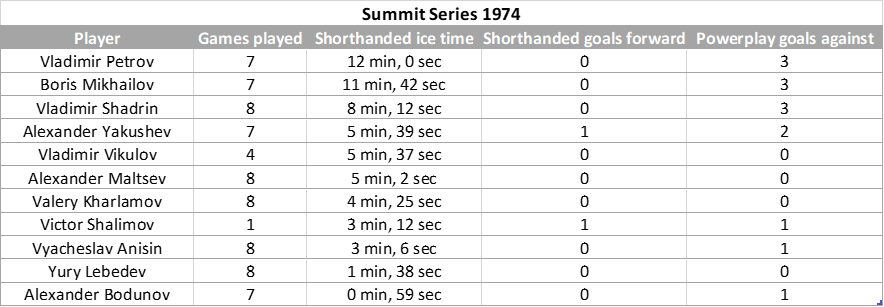








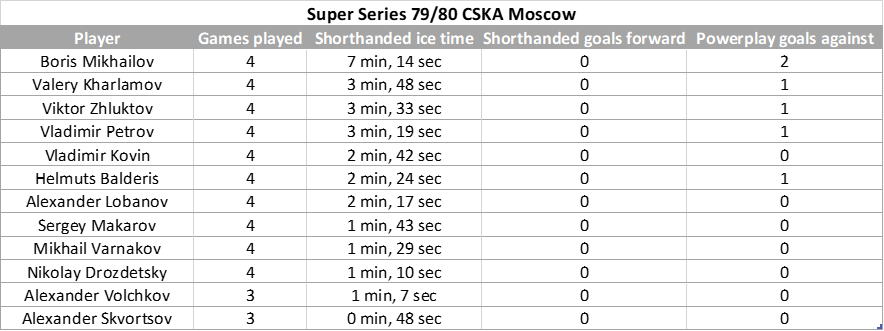
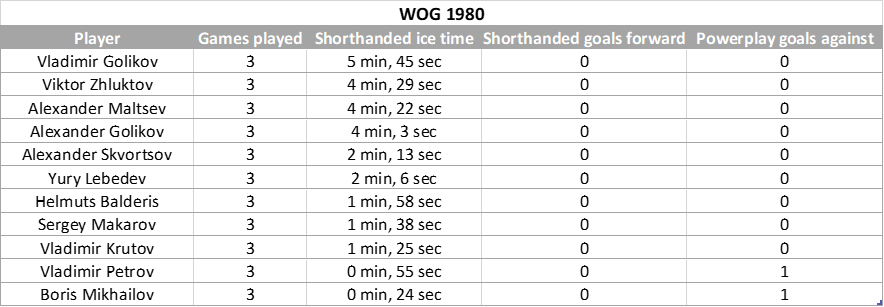

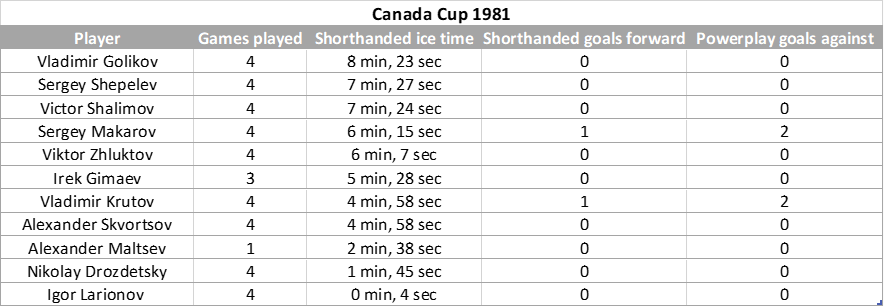

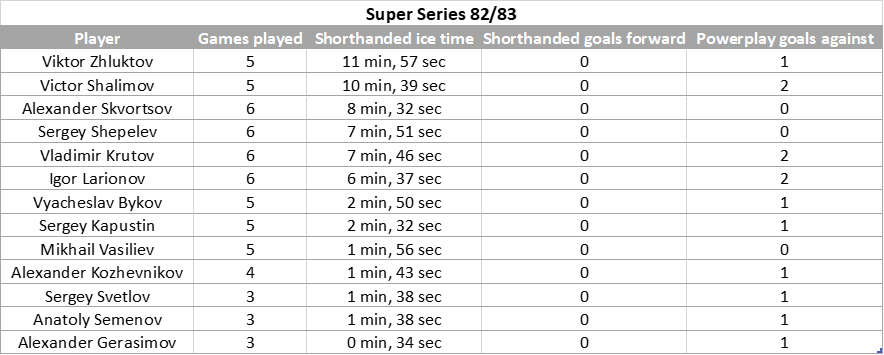


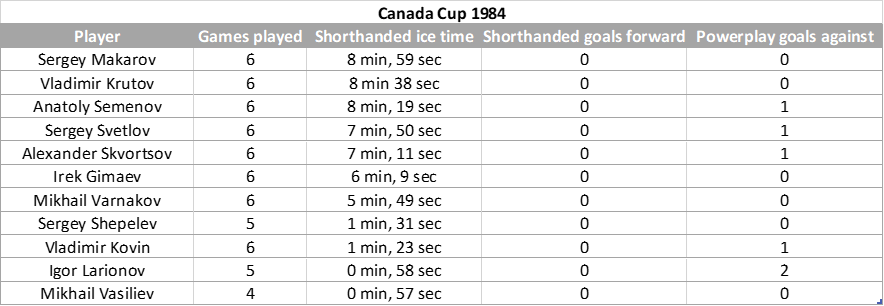
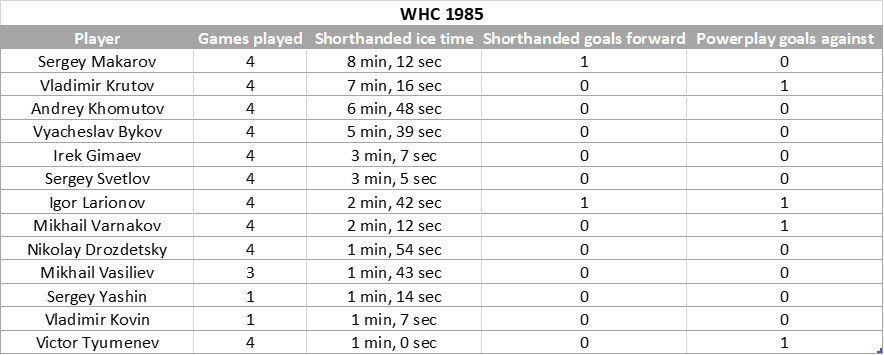

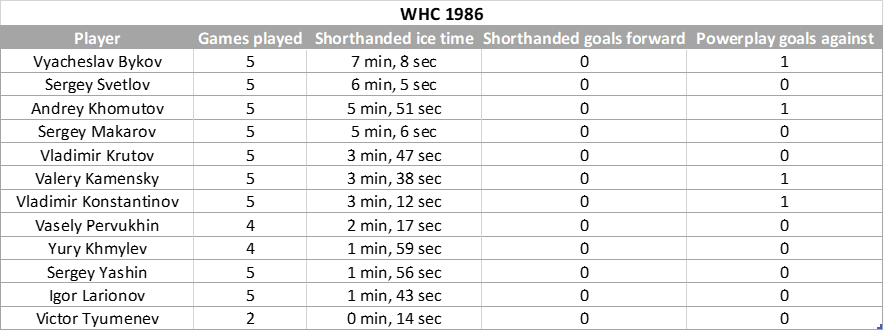

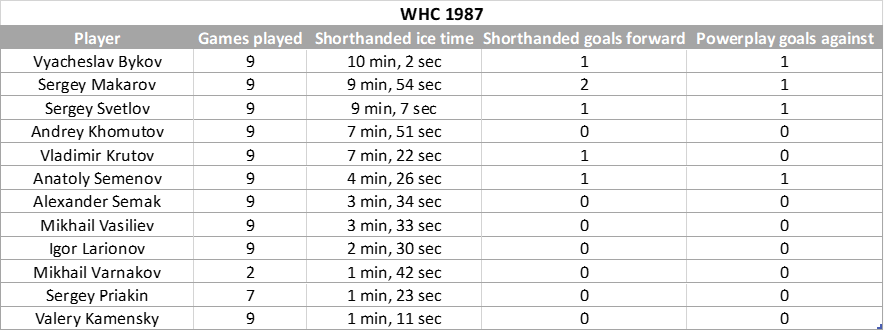
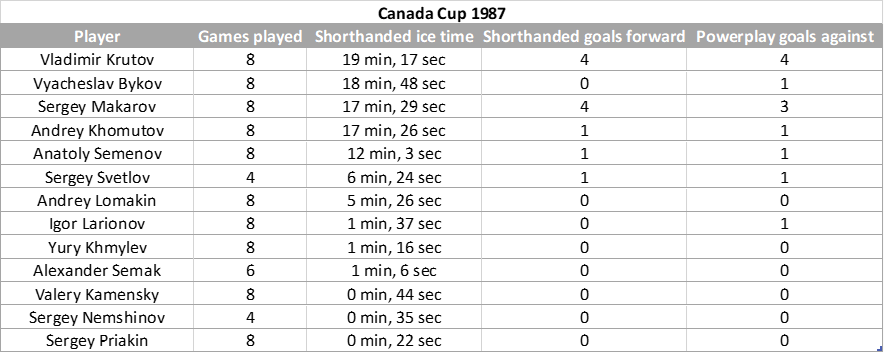

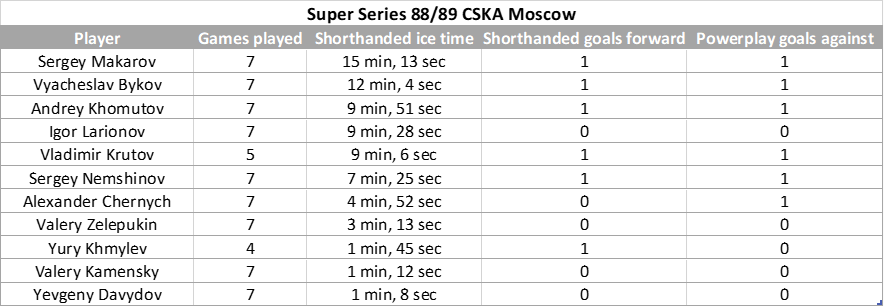
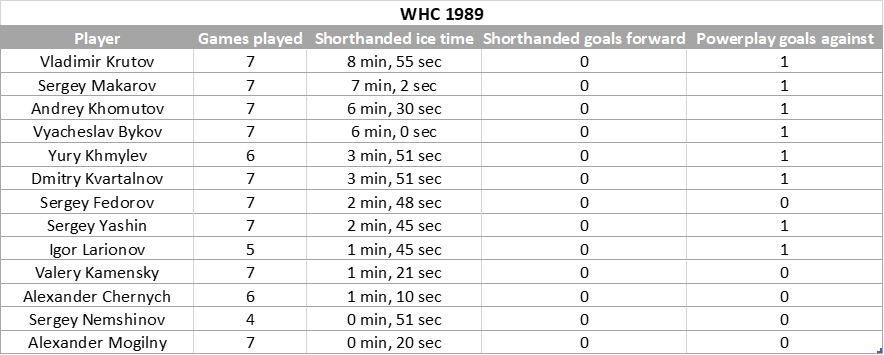
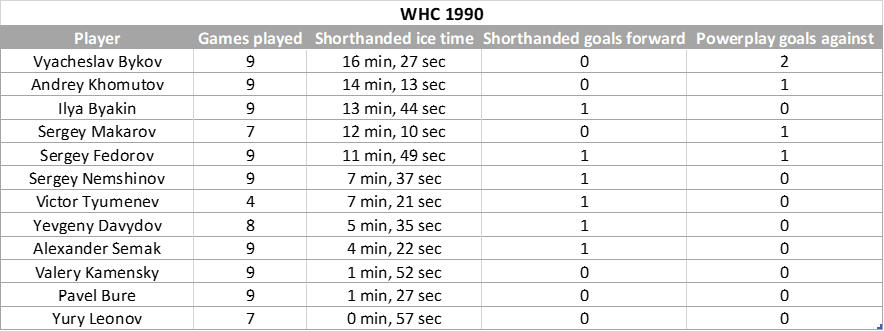
Some general comments:
The Soviet forwards who
stood out the most when it comes to penalty killing during the 1960-1990 time
frame were in my opinion the following.
- Alexander Almetov and Konstantin Loktev who dominated the first half of the 60's.
- Vyacheslav Starshinov and Anatoly Firsov who dominated the second half of the 60's.
- Vladimir Petrov and Boris Mikhailov who were the leading penalty killers during much of the 70's with their closest competitor being Vladimir Shadrin.
- Vladimir Golikov and Viktor Zhluktov who were the leading penalty killers of the late 70's-early 80's with their closest competitors being Victor Shalimov and Alexander Golikov.
- Sergey Makarov and Vladimir Krutov who dominated the mid and late 80's. Their strongest competitors were Vyacheslav Bykov and Andrey Khomutov.
These 10 players who were
the leading penalty killers over a significant time period (Almetov, Loktev,
Starshinov, Firsov, Mikhailov, Petrov, V Golikov, Zhluktov, Makarov and Krutov)
would probably be my top 10 greatest Soviet penalty killing forwards with Bykov
being the strongest other candidate for the top 10.
The player who was the most
positive surprise for me during this study was Alexander Maltsev who spent alot
more time killing penalties throughout his career than I had expected. Just
like many other Soviet greats Maltsev largely built his penalty killing on puck
possession but for a player who does not have much of a defensive reputation
his performance in his own zone while shorthanded also impressed me. Other
players who were positive surprises for me was Victor Shalimov and Vladimir
Vikulov. Especially Shalimov who was top 2 in shorthanded ice time during 4
tournaments/series with the national team.
The players who on the
other hand surprised me the most in a negative way were probably Sergey
Kapustin and (relatively speaking) Vladimir Shadrin. While Shadrin was one of
the greatest Soviet penalty killers during the 72-77 timeframe and his
performance in the 1976 WOG game against Czechoslovakia was absolutely
incredible I had still expected more from him. Perhaps my expectations were too
high but having that game in mind before doing this study I expected Shadrin to
be among the 5-10 players who would impress me the most and he did not really
meet those expectations.
Regarding Kapustin I was
already aware that he did not spend that much time on the penalty kill but I
had still expected him to rank somewhat higher in the Soviet penalty killing
hierarchy than he did during this sample. On both of the two great lines that
Kapustin played (Kapustin-Zhluktov-Balderis and Kapustin-Shepelev-Shalimov) he
was clearly the player who logged the least amount of shorthanded ice time.
When it comes to his actual performance when he did kill penalties I don't have
many complaints though.
I guess that some might
wonder why I included the Super Series stats of CSKA Moscow but not of other
Soviet club teams. The reason is simply that the competition for the spots on
the CSKA penalty kill in my opinion was close enough to the competition on the
national team for me to include the stats here. At the time of the 85/86 and
88/89 Super Series CSKA had all of the 4 greatest penalty killers from the
national team (Makarov, Krutov, Bykov and Khomutov) with only Svetlov and
Semenov playing on another team out of the top penalty killers. At the time of
the 75/76 and 79/80 Super Series some of the top penalty killers from the
national team were on other teams though. Shadrin and Shalimov were among the
very greatest penalty killers on the national team at the time of the 75/76
series and the Golikov brothers were probably the greatest penalty killers on
the national team at the time of the 79/80 series. Still the competition on
CSKA during that time was very strong with all of Zhluktov, Mikhailov and Petrov
being among the top penalty killers of that time frame.
Here are the goal differential stats of players with
more than 20 minutes of total shorthanded ice time.
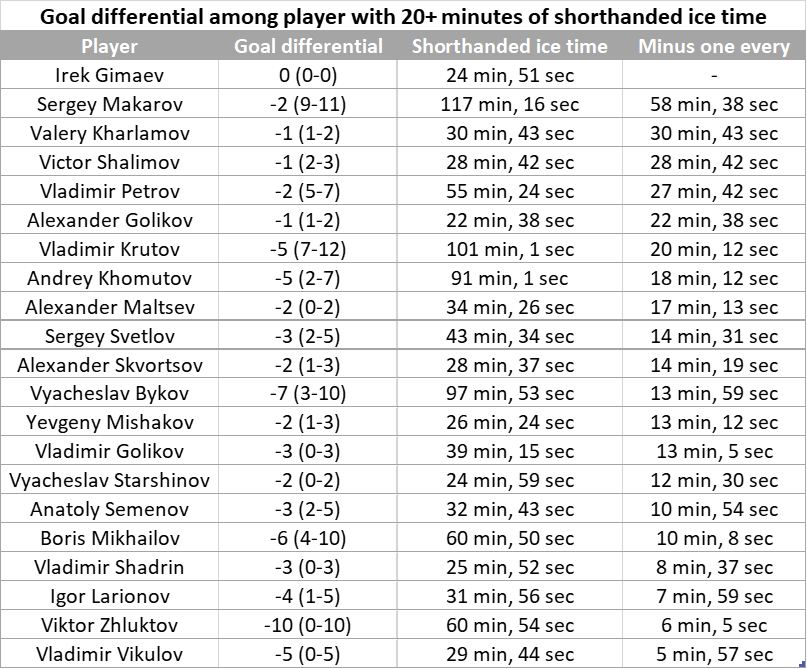
While it obviously is very impressive that Irek Gimaev had a goal differential of 0 over 24 minutes and 51 seconds of shorthanded ice I would still say that Vladimir Petrov and especially Sergey Makarov were the most impressive players from a goal differential perspective.
Sergey Makarovs goal
differential of -2 over 117 minutes and 16 seconds of shorthanded ice time is
an absolutely incredible stat.
Vladimir Petrovs -2 over 55
minutes and 24 seconds is also extremely impressive and an indication of his
all-around ability as a penalty killer. Truly great both with and without the
puck.
Outside of Makarov, Petrov
and Gimaev other players with very impressive goal differential stats were
Shalimov, Kharlamov and A.Golikov who all were -1 over ice times in the 20-30
minutes range. In that group I would also include Krutov and Khomutov who
averaged -1 every 20 min, 12 sec and 18 min, 12 sec over a very large sample of
shorthanded ice time.
The players with somewhat
weaker goal differential stats were Shadrin, Larionov, Zhluktov and Vikulov.
Since Zhluktov has such a large sample of ice time I think that his goal
differential stats are stronger than the others in that group. If we only look
at the 1981 Canada Cup, 1982 WHC, 82/83 Super Series and 1983 WHC for example
Zhluktov has -1 over more than 26 minutes.
And here are some players
with very impressive goal differential stats over ice times in the 5-20 minutes
range.
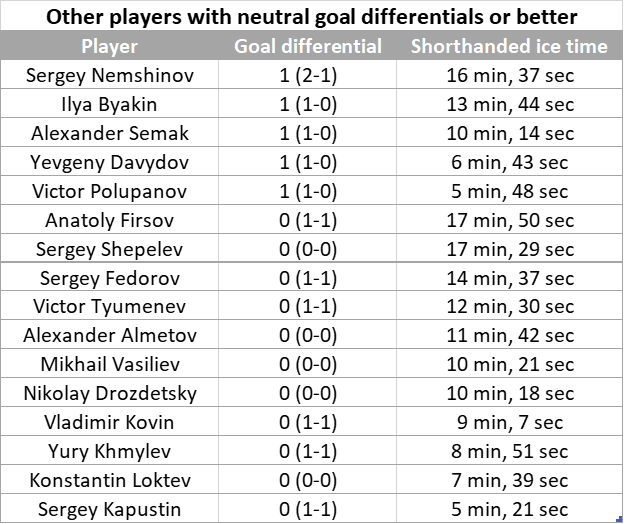
Here is a look at the goal differential among players with more than 20 minutes of shorthanded ice time in Summit Series, Canada Cup, Challenge Cup, Rendezvous and Super Series competition.
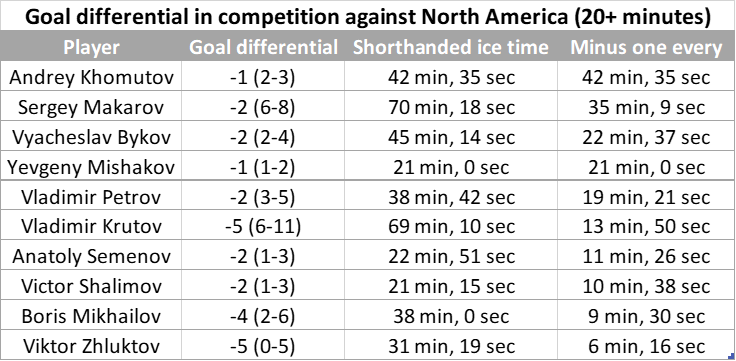
Somewhat surprisingly it was Andrey Khomutov who had the best shorthanded goal differential in these tournaments/series. It is however perhaps worth noting that Sergey Makarov (who is second on the goal differential list) actually had a better goal differential than Khomutov in the tournaments/series where the latter had any shorthanded ice time. In those tournaments/series Makarov had a goal differential of -1 (5-6) over the course of 53 minutes and 21 seconds of shorthanded ice time while Khomutov had -1 (2-3) over 42 minutes and 35 seconds.
The rest of this study can be found in this
thread. https://forums.hfboards.com/threads/study-of-the-penalty-killing-of-soviet-forwards-during-the-1960-1990-time-frame.2432151/